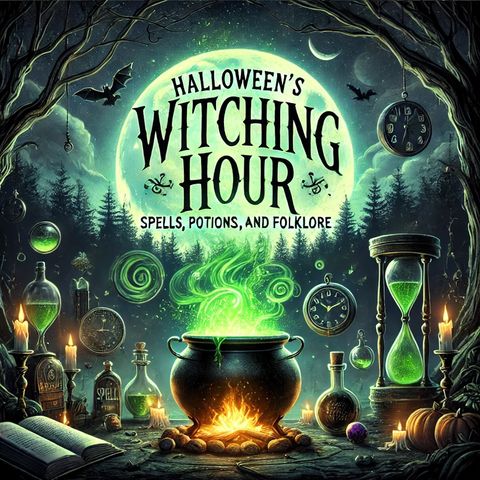Halloween's Witching Hour: Spells, Potions, and Folklore - Part 2 In the first part of our exploration into Halloween's witching hour, we delved into the historical roots of witchcraft and its influence on Halloween traditions. Now, let's continue our journey by examining how these ancient practices and beliefs have evolved into modern witchcraft and contemporary Halloween celebrations. The 20th century saw a dramatic shift in attitudes towards witchcraft. As societies became more secular and scientific understanding advanced, the old fears and superstitions began to fade. At the same time, there was a growing interest in alternative spiritualities and ancient traditions. This cultural climate set the stage for the emergence of modern witchcraft and Neopaganism. One of the most significant developments in modern witchcraft was the creation of Wicca. Founded in the 1950s by Gerald Gardner, Wicca drew on what Gardner claimed were surviving remnants of ancient pagan religions, combined with ceremonial magic and other esoteric traditions. Wicca and other forms of modern Paganism have reclaimed and reinterpreted many of the symbols and practices once associated with witchcraft, including the celebration of seasonal festivals like Samhain. Samhain, the ancient Celtic festival that contributed to the formation of Halloween, holds a special place in modern Pagan and Wiccan practice. Celebrated on October 31st or November 1st, Samhain is considered by many to be the Witch's New Year. It's seen as a time when the veil between the worlds of the living and the dead is at its thinnest, making it ideal for divination, communicating with ancestors, and magical workings. Many modern witches and Pagans incorporate traditional Halloween customs into their Samhain celebrations, seeing them as contemporary expressions of ancient spiritual practices. Jack-o'-lanterns, for instance, are often used in Samhain rituals as symbols of guidance for ancestral spirits. The practice of dressing up in costumes is sometimes interpreted as a form of sympathetic magic, allowing the practitioner to take on different aspects or energies. The influence of witchcraft on modern Halloween celebrations extends far beyond the Pagan community. The image of the witch has become an integral part of Halloween iconography, appearing in decorations, costumes, and media. This popular image often blends elements from various historical and fictional sources - the pointed hat of medieval woodcuts, the cauldron of Shakespeare's Macbeth, the green skin of the Wicked Witch of the West from The Wizard of Oz. In recent years, there has been a surge of interest in witchcraft and the occult, particularly among young people. This "witch aesthetic" has manifested in fashion, social media trends, and popular culture. Hashtags like #WitchesOfInstagram have millions of posts, while TikTok has seen the rise of "WitchTok," where users share spells, rituals, and magical advice. This mainstream fascination with witchcraft reaches its peak around Halloween. Stores fill with witch-themed merchandise, from playful decorations to more serious items like tarot decks and spell books. Halloween parties might feature fortune-telling booths or "potion-making" stations (often serving themed cocktails). Even those who don't practice witchcraft often enjoy incorporating magical elements into their Halloween celebrations, adding an air of mystery and enchantment to the holiday. The practices associated with witchcraft have also evolved over time. While the stereotypical image of a witch might involve elaborate rituals and exotic ingredients, modern witchcraft often emphasizes personal empowerment, connection with nature, and practical magic for everyday life. Many contemporary witches practice "kitchen witchery," incorporating magical intent into cooking and household tasks, or "green witchcraft," which focuses on working with herbs and plants. Divination, long associated with witchcraft and Halloween, remains popular. Tarot cards, crystal balls, and scrying mirrors are common tools. On Halloween night, when the veil between worlds is said to be thin, many people - not just practicing witches - engage in divination practices. Fortune-telling games at Halloween parties are a playful modern echo of this tradition. Spell-casting, another practice traditionally associated with witches, has also been reinterpreted in modern times. Rather than the curses and hexes of folklore, many modern practitioners focus on positive magic - spells for healing, protection, or personal growth. Candle magic, where specific colors of candles are used to focus intent, is particularly popular and often features in Halloween-themed magical workings. The connection between witchcraft and nature, always strong in folklore and mythology, has taken on new significance in the face of environmental concerns. Many modern witches and Pagans see their practices as a way to reconnect with the natural world and advocate for its protection. This eco-conscious aspect of modern witchcraft often manifests in Halloween and Samhain celebrations that honor the changing of the seasons and the cycle of nature. As we conclude our exploration of Halloween's witching hour, it's clear that the relationship between witchcraft and Halloween is a complex and evolving one. From ancient Celtic festivals to medieval witch hunts, from Hollywood depictions to modern Pagan practices, the figure of the witch has been continually reimagined and reinterpreted. Today, witchcraft and Halloween have become intertwined in popular culture, each influencing and reinforcing the other. The witch has been transformed from a figure of fear to one of fascination, empowerment, and even whimsical fun. As the jack-o'-lanterns glow and the veils between worlds thin, the magic of Halloween continues to cast its spell, inviting us all to explore the mysterious, the supernatural, and the enchanted. Whether you're a practicing witch, a Halloween enthusiast, or simply curious about the magical side of life, Halloween offers a unique opportunity to connect with the rich tapestry of human beliefs and practices surrounding magic and the supernatural. As you celebrate this Halloween, perhaps you'll feel a touch of that ancient magic in the air - the same magic that has captivated imaginations for thousands of years.
mostra menos


Comentarios